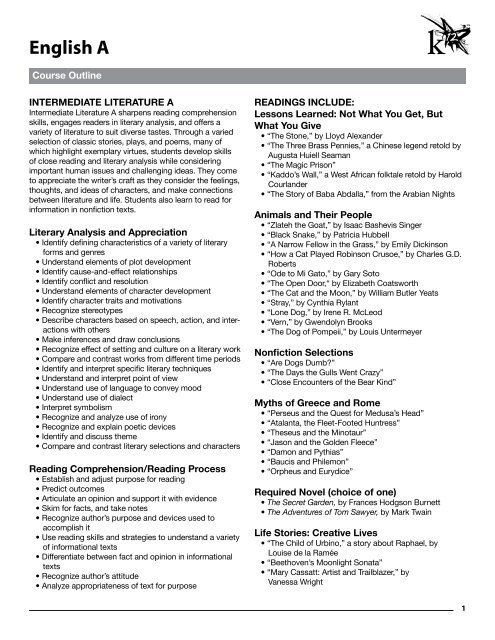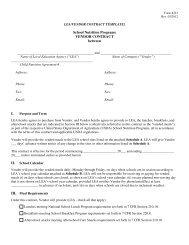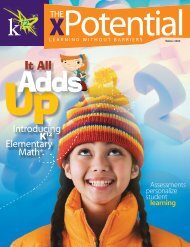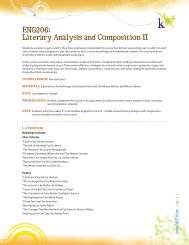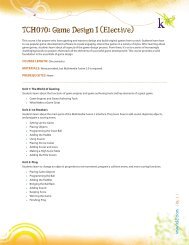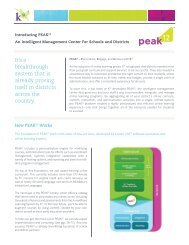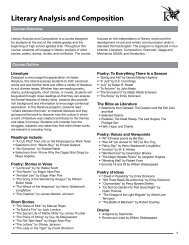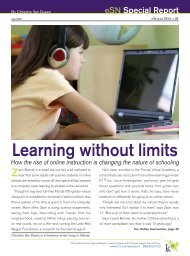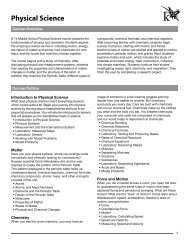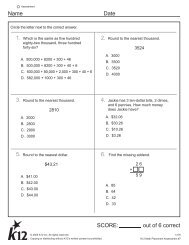English A - K12.com
English A - K12.com
English A - K12.com
- No tags were found...
Create successful ePaper yourself
Turn your PDF publications into a flip-book with our unique Google optimized e-Paper software.
<strong>English</strong> ACourse OutlineINTERMEDIATE LITERATURE AIntermediate Literature A sharpens reading comprehensionskills, engages readers in literary analysis, and offers avariety of literature to suit diverse tastes. Through a variedselection of classic stories, plays, and poems, many ofwhich highlight exemplary virtues, students develop skillsof close reading and literary analysis while consideringimportant human issues and challenging ideas. They cometo appreciate the writer’s craft as they consider the feelings,thoughts, and ideas of characters, and make connectionsbetween literature and life. Students also learn to read forinformation in nonfiction texts.Literary Analysis and Appreciation• Identify defining characteristics of a variety of literaryforms and genres• Understand elements of plot development• Identify cause-and-effect relationships• Identify conflict and resolution• Understand elements of character development• Identify character traits and motivations• Recognize stereotypes• Describe characters based on speech, action, and interactionswith others• Make inferences and draw conclusions• Recognize effect of setting and culture on a literary work• Compare and contrast works from different time periods• Identify and interpret specific literary techniques• Understand and interpret point of view• Understand use of language to convey mood• Understand use of dialect• Interpret symbolism• Recognize and analyze use of irony• Recognize and explain poetic devices• Identify and discuss theme• Compare and contrast literary selections and charactersReading Comprehension/Reading Process• Establish and adjust purpose for reading• Predict outcomes• Articulate an opinion and support it with evidence• Skim for facts, and take notes• Recognize author’s purpose and devices used toaccomplish it• Use reading skills and strategies to understand a varietyof informational texts• Differentiate between fact and opinion in informationaltexts• Recognize author’s attitude• Analyze appropriateness of text for purposeReadings include:Lessons Learned: Not What You Get, ButWhat You Give• “The Stone,” by Lloyd Alexander• “The Three Brass Pennies,” a Chinese legend retold byAugusta Huiell Seaman• “The Magic Prison”• “Kaddo’s Wall,” a West African folktale retold by HaroldCourlander• “The Story of Baba Abdalla,” from the Arabian NightsAnimals and Their People• “Zlateh the Goat,” by Isaac Bashevis Singer• “Black Snake,” by Patricia Hubbell• “A Narrow Fellow in the Grass,” by Emily Dickinson• “How a Cat Played Robinson Crusoe,” by Charles G.D.Roberts• “Ode to Mi Gato,” by Gary Soto• “The Open Door,“ by Elizabeth Coatsworth• “The Cat and the Moon,” by William Butler Yeats• “Stray,” by Cynthia Rylant• “Lone Dog,” by Irene R. McLeod• “Vern,” by Gwendolyn Brooks• “The Dog of Pompeii,” by Louis UntermeyerNonfiction Selections• “Are Dogs Dumb?”• “The Days the Gulls Went Crazy”• “Close Encounters of the Bear Kind”Myths of Greece and Rome• “Perseus and the Quest for Medusa’s Head”• “Atalanta, the Fleet-Footed Huntress”• “Theseus and the Minotaur”• “Jason and the Golden Fleece”• “Damon and Pythias”• “Baucis and Philemon”• “Orpheus and Eurydice”Required Novel (choice of one)• The Secret Garden, by Frances Hodgson Burnett• The Adventures of Tom Sawyer, by Mark TwainLife Stories: Creative Lives• “The Child of Urbino,” a story about Raphael, byLouise de la Ramée• “Beethoven’s Moonlight Sonata”• “Mary Cassatt: Artist and Trailblazer,” byVanessa Wright1
<strong>English</strong> A• “Young Pablo Casals,” by Mara Rockliff• “Marian Anderson Sings,” by Mara RockliffFavorites from Famous Books: The JungleBook, by Rudyard Kipling• “Mowgli’s Brothers”• “Tiger! Tiger!’”• “The Tyger,” by William BlakeA Matter of Justice• “The Wisdom of Solomon”• “A Just Judge,” by Leo Tolstoy• “Ooka and the Honest Thief,“ a Japanese folktale retoldby I.G. Edmonds• “Mohandas Gandhi: Truth in Action,” by Vanessa Wright• “Equal Justice Under Law: Thurgood Marshall,” byMara RockliffShakespeare• Twelfth Night (in the Shakespeare for Young Peopleadaptation)Bible Characters and Stories• “Moses: The Long Journey Through the Wilderness”• “The Fiery Furnace”• “The Parable of the Good Samaritan”Stories of Our Time• “Thank You, M’am,” by Langston Hughes• “The Circuit,” by Francisco Jiménez• “The Bracelet,” by Yoshiko Uchida• “The Strangers That Came to Town,” by Ambrose FlackPoetry: “To Everything There Is a Season”• “Waiting,” by Harry Behn• “Something Told the Wild Geese,” by Rachel Field• Haiku (selections) translated by Harry Behn• “Check,” by James Stephens• “The Pasture,” by Robert Frost• “A Wintry Sonnet,” by Christina Rossetti• “The Morns Are Meeker Than They Were,” byEmily Dickinson• “The Storm,” by Walter De La Mare• “Swift Things Are Beautiful,” by Elizabeth Coatsworth• “I Wandered Lonely As a Cloud,” by William Wordsworth• “Until I Saw the Sea,” by Lillian Moore• “To everything there is a season” from the Book ofEcclesiastesStuff and Nonsense• Selections from Alice’s Adventures in Wonderland, byLewis Carroll• “The Walrus and the Carpenter,” by Lewis Carroll• Limericks by Edward Lear• Poems by Ogden NashNOVELSThis program allows students to read any three novels oftheir choice from a selection of award-winning works byrenowned authors, from a variety of genres: fantasy, sciencefiction, historical fiction, realistic fiction, and mystery.These novels are listed in order of increasing difficulty asmeasured by the Lexile scale, a system that measuresreading difficulty by sentence length and vocabulary (seewww.lexile.com). Lexile ratings roughly correspond to gradelevels as indicated below.Approximate Grade Level Lexile Range5 750-9506 850-10507 950-10758 1000-11009 1050-115010 1100-1200Lexile levels are only one means of assessing whether awork is appropriate for your student. When selecting anovel, keep in mind that the Lexile rating does not measuresubject matter or themes in the work.Title and AuthorLexile LevelFrom the Mixed-up Files ofMrs. Basil E. Frankweiler, by E.L. Konigsburg.................. 700A Wrinkle in Time, by Madeleine L’Engle......................... 740The Martian Chronicles, by Ray Bradbury....................... 740The Outsiders, by S.E. Hinton.......................................... 750The Bronze Bow, by Elizabeth George Speare................ 760Walk Two Moons, by Sharon Creech............................... 770War Comes to Willie Freeman, by Christopherand Lincoln Collier............................................................ 770The Sign of the Beaver, by Elizabeth George Speare...... 770The Book of Three, by Lloyd Alexander........................... 770Tuck Everlasting, by Natalie Babbitt................................. 770My Side of the Mountain, by Jean Craighead George.... 810Johnny Tremain, by Esther Forbes................................... 840The Fellowship of the Ring, by J.R.R. Tolkein.................. 860The Cay, by Theodore Taylor............................................ 860Dragonwings, by Laurence Yep....................................... 870Jacob Have I Loved, by Katherine Paterson.................... 880Old Yeller, by Fred Gipson................................................ 910
<strong>English</strong> ARoll of Thunder, Hear My Cry, by Mildred D. Taylor......... 920The Dark Is Rising, by Susan Cooper.............................. 920The Lion, the Witch and the Wardrobe, by C.S. Lewis.... 940Bud, Not Buddy, by Christopher Paul Curtis................... 950White Fang, by Jack London........................................... 970Anne of Green Gables, by Lucy Maud Montgomery....... 990The Door in the Wall, by Marguerite de Angeli................. 990Island of the Blue Dolphins, by Scott O’Dell..................1000Ben and Me, by Robert Lawson....................................101020,000 Leagues Under the Sea, by Jules Verne............1030Hound of the Baskervilles, by Arthur Conan Doyle........1090Across Five Aprils, by Irene Hunt...................................1100Catherine, Called Birdy, by Karen Cushman..................1170War of the Worlds, by H.G. Wells...................................1170Swiss Family Robinson, by Johann Wyss......................1260The Incredible Journey, by Sheila Burnford...................1320INTERMEDIATE LANGUAGE SKILLS AIntermediate Language Skills A offers a systematicapproach to the development of written and oralcommunication skills, and is designed to give studentsthe essential building blocks for expressing their ownideas in standard (or formal) <strong>English</strong>.COMPOSITIONAfter an opening focus on paragraph writing, students writea variety of compositions in genres they will encounterthroughout their academic careers, including: compare-andcontrast,persuasive, how-to, and research essays. In writingeach essay, students go through a process of planning,organizing, and revising, and they learn to examine theirown writing with a critical eye, paying attention to ideas,organization, structure, style, and correctness. Throughout thecourse, students write in response to prompts similar to thosethey will encounter on standardized tests.Introduction to Paragraph• Parts of a Paragraph• Paragraph Decisions• Paragraph Conventions• Writing a Paragraph• Revising a ParagraphPersonal Narrative• What Is a Personal Narrative?• Prewriting: Investigating Ideas for a Personal Narrative• Prewriting: Using Language That Shows• Drafting: Writing a Personal Narrative• Revising, Proofreading, PublishingCompare and Contrast Essay• What Is a Compare and Contrast Essay?• Prewriting: Planning a Compare and Contrast Essay• Drafting: Writing a Compare and Contrast Essay• Revising: Revising a Compare and Contrast Essay• Proofreading and PublishingPersuasive Essay• What Is a Persuasive Essay?• Prewriting: Logical Thinking• Prewriting: Fact vs. Opinion• Prewriting: Structure of a Persuasive Essay• Prewriting: Planning a Persuasive Essay• Prewriting: Organizing a Persuasive Essay• Drafting: Writing a Persuasive Essay• Revising a Persuasive Essay• Proofreading and Publishing a Persuasive EssayResearch Report• What Is a Research Report?• Covering the Basics• Prewriting: Finding Information• Prewriting: Finding More Information• Prewriting: Taking Notes• Prewriting: Organizing the Information• Drafting• Revising• Bibliography• Proofreading• PublishingHow-To Essay• What Is a How-to Essay?• Prewriting: Planning a How-to Essay• Drafting: Writing a How-to Essay• Revising and Proofreading• PublishingAdvertisements• What Are Advertisements?• Planning an Advertisement• Creating an Advertisement• Planning a Presentation• Practicing Your Presentation• Delivering a PresentationBook Review• What Is a Book Review?• Prewriting: Planning a Book Review• Prewriting: Summarizing• Drafting: Writing a Book Review• Revising, Proofreading, and Publishing
<strong>English</strong> AGRAMMAR, USAGE, AND MECHANICSThe Grammar, Usage, and Mechanics program offerspractice in sentence analysis, sentence structure, andproper punctuation. Students learn to diagram sentencesin order to understand how words, phrases, and clausesfunction in relation to each other. Frequent exercises andregular practice help students absorb the rules so they canconfidently apply them in their own writing. The BarrettKendall Language Handbook provides exercises and aready resource for grammar rules and conventions.The Sentence• Positions of Subjects• Sentence Fragments• Ways to Correct Sentence Fragments• Sentence Diagramming and ReviewNouns and Pronouns• Common and Proper Nouns• Pronoun Antecedents• Personal Pronouns• Reflexive Pronouns• Indefinite Pronouns• Demonstrative Pronouns• Sentence Diagramming and ReviewVerbs and Complements• Action Verbs• Helping Verbs• Direct Objects• Indirect Objects• Transitive and Intransitive Verbs• Linking Verbs• Predicate Nominatives• Sentence Diagramming and ReviewAdjectives and Adverbs• Adjectives• Articles• Proper Adjectives• Predicate Adjectives• Adverbs• Adverbs that Describe Verbs• Adverbs that Modify Adjectives and Other Adverbs• Sentence Diagramming and ReviewOther Parts of Speech• Prepositions• Prepositional Phrases• Preposition or Adverb?• Conjunctions and Interjections• Sentence Diagramming and ReviewPhrases• Adjective Phrases• Prepositional Phrases• Adjective Phrases• Misplaced Adjective Phrases• Adverb Phrases• Appositives and Appositive Phrases• Sentence Diagramming and ReviewSentence Structure• Simple Sentences• Compound Sentences• Run-on Sentences• Sentence Diagramming and Review• Diagramming Compound SentencesUsing Verbs• Regular and Irregular Verbs• Principal Parts of Verbs• Problem Verbs• Verb Tenses• Tense Shifts• Progressive Verb FormsUsing Pronouns• Kinds of Pronouns• Subject Pronouns• Pronouns Used as Subjects• Pronouns Used as Predicate Nominatives• Pronouns Used as Direct Objects• Pronouns Used as Indirect Objects• Pronouns Used as Objects of Prepositions• Possessive Pronouns• Possessive Pronoun or Contraction?• Pronoun Problem: Who or Whom?• Pronouns and Their Antecedents• Indefinite Pronouns as AntecedentsSubject and Verb Agreement• Number• The Number of Nouns and Pronouns• The Number of Verbs• Singular and Plural Subjects• Common Agreement Problems• Verb Phrases• Doesn’t or Don’t• Prepositional Phrases after Subjects• Subjects after Verbs• Compound Subjects• Agreement Problems with Pronouns• You and I as Subjects• Indefinite Pronouns
<strong>English</strong> AUsing Adjectives and Adverbs• Comparison of Adjectives and Adverbs• Regular Comparisons• Irregular Comparisons• Problems with Modifiers• Double Comparisons• Double Negatives• Good or Well?Capital Letters• First Words and the Pronoun I• Sentences• Lines of Poetry• Parts of Letters• Outlines• The Pronoun I• Proper Nouns• Proper Adjectives• Titles• Names of People• Direct Address• Written Works and Other Works of ArtEnd Marks and Commas• End Marks• Other Uses of Period• Commas that Separate• Items in a Series• Compound Sentences• Introductory Words and Phrases• Direct Address• Appositives• Commonly Used CommasItalics and Quotation Marks• Titles with Italics• Titles with Quotation Marks• Quotation Marks with Direct Quotations• Capital Letters with Direct Quotations• Commas with Direct Quotations• End Marks with Direct Quotations• Writing DialogueOther Punctuation• Apostrophes to Show Possession• Possessive Forms of Singular Nouns• Possessive Forms of Plural Nouns• Possessive Forms of Pronouns• Contractions• Apostrophes with Contractions• Contraction or Possessive Pronoun?• Apostrophes with Certain Plurals• Semicolons• Colons• Hyphens with Divided Words• Other Uses of the HyphenVOCABULARYThe Vocabulary from Classical Roots program buildsknowledge of Greek and Latin words that form the roots ofmany <strong>English</strong> words, especially the polysyllabic terms thatsometimes cause students to stumble. Throughout thisprogram, students will define and use words with Greekand Latin roots, and use word origins and derivations todetermine the meaning of new words, as they increase theirown vocabularies and develop valuable test-taking skills.Numbers• Greek root monos• Latin roots unus, duo, duplex, bi• Greek root tri• Latin roots tres, quartus, quatuor, decem, centumAll or Nothing• Greek roots pan, holos• Latin roots omnis; totus; claudo, claudere, clausi,clausum• Latin roots incipio, incipere, incepi, inceptum; nihil; nego,negare, negavi, negatum; vanus, vacuus; aperio, aperire,aperui, apertumMore or Less• Greek root micros• Latin roots minuo, minuere, minui, minutum; minus;tenuo, tenuare, tenuavi, tenuatum tenuis; satis; impleo,implere, implevi, impletum; plenus• Greek roots macros, megas, poly• Latin roots copia, magnusBefore and After• Latin roots ante, pre• Latin roots primus, postCreativity• Greek root aoide• Latin roots ars, artis, canto, cantare, cantavi, catatum;pingo, pingere, pinxi, pictum• Latin roots cresco, crescere, crevi, cretum; facio, facere,feci, factum, texo, texere, texui, textumTravel• Greek root hodos• Latin roots trans, eo, ire, ivi, itum, erro, errare, erravi,erratum
<strong>English</strong> A• Greek root tele• Latin roots iter, itineris, venio, venire, veni, ventum, viaSports• Latin roots celer, curro, currere, cucurri, cursum, cursor,cursoris, glomus, jacio, jacere, jeci, jactum• Latin roots salio, salire, salui, saltum, valeo, valere, valui,valitum, volvo, volvere, volvi, volutumAnimals• Latin roots apis, asinus, avis, bos, bovis; canis, caper,capra, equus• Greek roots leon, zoion, zoa• Latin roots felis, leo, leonis, piscis, porcus, serpens,serpentis, simia, ursa


